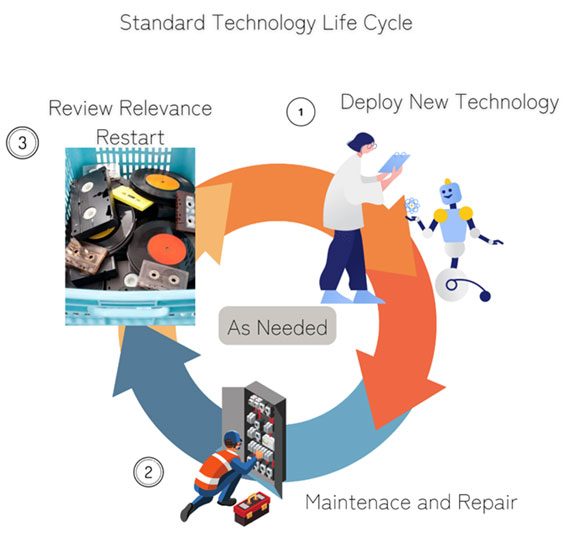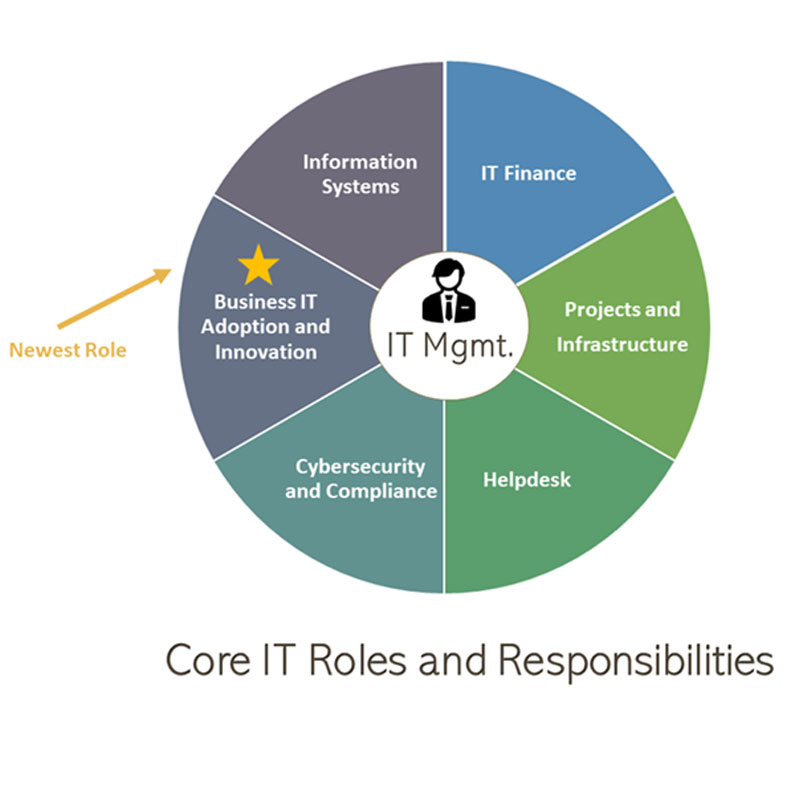Table of Contents
ToggleTechnology is becoming more bolt-on and turnkey-enabled than ever before. Hardware is cheap and disposable, requiring a good technology lifecycle strategy vs. technology repairs. Executives and IT leaders need to stop fighting and start the processes of technological scalability. Looking for gaps in processes, understanding business goals, can provide technological operational improvements making your company thrive in the changing market landscape.
Below are a few significant concepts to help get you started.
Understanding the Organization’s Business Goals in Relation to Technology:
Business Problem Example:
Electronic Health record tasks didn’t get completed promptly, holding the process for billing. This example caused a delay in cash received.
- Operational management doesn’t have visibility of needed shortcomings.
- EHRs don’t have the reports for this direct problem and many others.
- Operations and patient accounting point fingers at each other, claiming they are doing what they need to.

Collaboration between patient accounting, operations, and IT to get a list of delinquent tasks and IT to provide training or assess if other technology or support is needed.
- The company should outline regularly scheduled checks for revenue-generating tasks or processes in the system and decide how they are communicated.
- IT can assist in completing tasks 1:1 or through training and guides.
- IT can offer technologies such as Dragon or other services.
- IT can identify and should propose the need for administrative assistance such as scribes and outsourced transcription services. In this scenario, the cost of these resources should be more than justified based on the additional patient time created.
- Operations can provide standards and procedures for how some individuals can complete the work promptly vs. others.
- Collectively, the teams can work together to improve the delivery time.
In this scenario, the company can figure out an essential step to achieving faster billing time and enabling feedback channels for some of the most critical business tasks.
Keeping Track of Your Markets and Organizational Why’s
Healthcare markets and companies are consolidating or starting to change how it is approached. Even if you’re going through a startup, merger, or acquisition, never lose focus on why your company is participating in change.
Business Problem Example:
Company A is acquiring Company B. What is the easy approach to technology chaos?
- What EHR, CRM, ERP, and so on?
- How should IT be structured?
- What are the impacts on patient healthcare quality?
Remembering the patient’s quality and why your organization’s work is so important is always the starting point. Discovery of change is required, however, keep these in mind:
- If STAYING on paper and not forcing a technology change will be the fastest approach to patient quality and billable outcomes, start here.
- Getting online the fastest with the least amount of risk is always the preferred method.
- Even running two systems and leaving things the way they are until planned changes over time can happen is a great approach.
- Don’t forget technology consolidation and economies of scale; understand how your vendors can help you.
- Examples: Copier companies hosting a catered lunch for reducing and consolidating copiers but celebrating a new contract renewal for the expanded opportunity
- Don’t change things to change them. Identify the needed changes for success.
- Outsourcing discovery between companies and market comparison assessments will help outline the process.
- Don’t assume either company is better equipped and skilled than the next.
- Understanding traditions and customs to the changes in a market space can create a road map to no loss of innovation.
- Do not forget about innovation and market comparison.
- Soon, PE companies will be grading a deal on their technological performance.
- Not all Companies are IT companies. However, companies that don’t get technology to become scalable are not immune to missing the opportunity to help patients.
- Patients and clients want to use technology.
IT Department and Executive Understanding
How does your IT department lead your organization? Do the company executives feel they are held hostage or is the IT department you delegate technology tasks to instead of including them in the business strategy process?
Quickly Grade Your IT Department:
Level 1: Flood and Fires? IT Chaos
Level 2: Things are okay in terms of break-fix; however, the company has no technology advantages.
Level 3: IT enables technology adoption without additional cost and drives business forward.
Assessing Your IT Department on the 6 Core Roles of IT:
1. IT Finance (Accounting, Procurement and Resource Management):
Evaluating existing financial systems and processes, assessing new financial opportunities, and allocating resources to maximize value.
2. Information Systems (Software and Data systems):
Evaluating existing software solutions, researching and applying new technologies, managing databases and data retention policies.
3. Projects and Infrastructure (New Technology):
Managing large-scale technology projects from concept to completion, overseeing infrastructure maintenance, and evaluating new technologies for potential adoption.
4. Help Desk (Break / Fix):
Providing technical support with hardware, software or network related issues; managing trouble-ticketing systems; continually improving service delivery methodology; ensuring user satisfaction is met with a quality experience every time.
5. Security Governance and Compliance (Technology and Administrative Safeguards):
Identifying risks that may impact confidentiality, integrity or availability; establishing necessary policies and procedures to ensure security compliance; researching emerging threats to stay ahead of malicious actors; developing training programs for employees who are responsible for dealing with sensitive customer data.
6. *NEW ROLE IN 2023* Business IT Adoption and Innovation (Technology, Change, and Adoption):
Ensuring compatibility between business models/strategies and technological developments through proactive measures; overseeing change management initiatives within the organization as technology evolves rapidly; providing leadership in developing strategies to effectively adopt/implement innovative technological solutions within the organization.
The IT department of your organization is leading the charge in many ways. With the ever-evolving technology landscape, the IT department needs to work hard to stay abreast of new developments and apply them strategically to help your business stay competitive. Your company executives should understand that this is not just a cost center but rather an invaluable asset that can help create value while also furthering business goals. By delegating certain technology tasks and incorporating others into the business strategy process, the IT department can become a cornerstone in helping your organization reach its objectives.
Healthcare IT Leadership in 2023
Healthcare IT Leadership in 2023 will challenge organizations to address the ever-changing landscape of healthcare. As technology continues to evolve, Healthcare IT Leaders must be ready to embrace new ways of working, innovate approaches to patient care, and use data-driven insights to optimize operational efficacy. With a focus on leveraging technology for improved patient outcomes, cost reduction and enhanced patient experience, Healthcare IT Leaders have a unique role in defining the future of healthcare and can play an integral part in transforming it.
ITSM is the integration of IT service management within an organization. ITSM describes how all of an organization’s information technology functions work together efficiently and profitably. Learn how our ITSM services can improve your organization.

With over 16 years in the industry, Jameson Lee has honed his skills in IT management, project execution, and strategic planning. His ability to align technology initiatives with business goals has consistently delivered remarkable results for organizations across various sectors.
Jameson’s educational background includes an Associate of Applied Science degree in Computer Networking Systems, providing him with a solid foundation in technical concepts and best practices. Complementing his technical acumen, he has also completed coursework in Business Administration, equipping him with a well-rounded understanding of the operational aspects of running successful businesses.
Driven by a commitment to staying ahead of industry trends, Jameson actively pursues professional certifications and continuous learning opportunities. His credentials include CompTIA A+, N+, and Security+, along with MCP and MCTS certifications. This dedication ensures that he remains at the forefront of technological advancements, enabling him to offer innovative solutions to complex challenges.
What sets Jameson apart is his personable approach to working with clients. He believes in fostering strong relationships and effective communication, collaborating closely with stakeholders to understand their unique needs, and provide tailored technology solutions. By building trust and understanding, Jameson ensures that every project is aligned with the client’s vision and objectives.
Throughout his career, Jameson has successfully led teams and implemented robust frameworks to optimize performance and achieve remarkable technological initiatives. Whether it’s streamlining operations, enhancing cybersecurity measures, or implementing cutting-edge software solutions, Jameson has consistently delivered tangible outcomes for his clients.
As a trusted IT partner, Jameson’s mission is to empower businesses with technology solutions that drive growth, efficiency, and competitive advantage. With his expertise, dedication, and personable approach, Jameson Lee is the catalyst for transforming your business through the power of technology.




